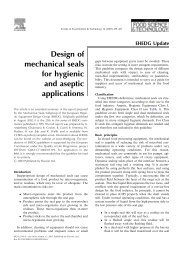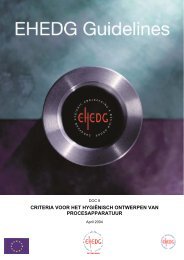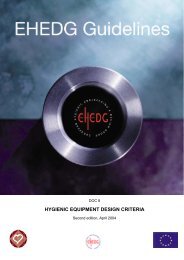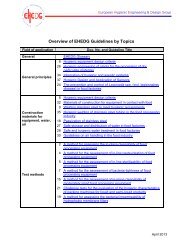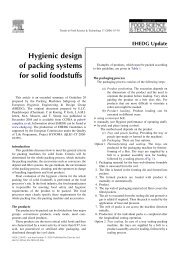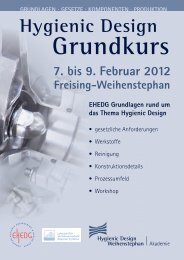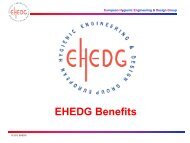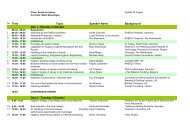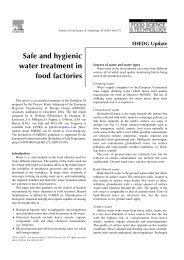Yearbook 2013/2014 - ehedg
Yearbook 2013/2014 - ehedg
Yearbook 2013/2014 - ehedg
Create successful ePaper yourself
Turn your PDF publications into a flip-book with our unique Google optimized e-Paper software.
EHEDG Subgroups 173<br />
EHEDG Subgroup “Separators”<br />
Reinhard Moss, e-mail: reinhard.moss@gea.com<br />
The Subgroup Separators is working on a new EHEDG<br />
document dealing with the hygienic aspects of disc stack<br />
centrifuges. These machines are used to separate fractions<br />
with different densities of liquid food products or to remove<br />
dense solid matter from products. Doc. 42 “Disc Stack<br />
Centrifuges” will be finished in spring <strong>2013</strong>.<br />
Many of the design principles applicable to this kind of<br />
equipment are already shown in the EHEDG Guidelines<br />
Doc. 8 Hygienic equipment design criteria; Doc. 9 Welding<br />
stainless steel to meet hygienic requirements; Doc. 10<br />
Hygienic design of closed equipment for the processing of<br />
liquid food; Doc. 16 Hygienic pipe couplings<br />
• Doc. 9 Welding stainless steel to meet hygienic<br />
requirements<br />
• Doc. 10 Hygienic design of closed equipment for the<br />
processing of liquid food<br />
• Doc. 16 Hygienic pipe couplings<br />
• Doc. 17 Hygienic design of pumps, homogenizers and<br />
dampening devices<br />
• Doc. 32 Materials of construction for equipment in<br />
contact with food<br />
• Doc. 35 Welding of stainless steel tubing in the food<br />
Industry<br />
The document was revised several times and descriptions<br />
for the hygienic design of special areas were added. Also<br />
illustrations, drawings and pictures were added to get<br />
the sanitary problem zones across to the users of the<br />
guideline.<br />
The Subgroup has defined specific rules applicable to the<br />
CIP-cleaning capability of separators which are not yet<br />
covered by existing EHEDG documents. Also other special<br />
hygienic design features necessary for this kind of machinery<br />
are also described.<br />
A final draft of the Guideline is currently going through the<br />
EHEDG Guideline approval process.<br />
Chairman:<br />
Reinhard Moß<br />
GEA Mechanical Equipment<br />
GEA Westfalia Separator Group GmbH<br />
Operative Technical Services<br />
Phone: +49 2522 77-2571<br />
Fax: +49 2522 77-32571<br />
Mobile: +49 172 536 8803<br />
E-mail: reinhard.moss@gea.com<br />
EHEDG Subgroup “Tank Cleaning”<br />
Design of tanks for cleanability and using cleaning devices<br />
Bo Boye Busk Jensen, e-mail: bobb.jensen@alfalaval.com<br />
The workgroup started at the beginning of 2012. The<br />
objective of the guideline has been discussed and is currently<br />
described as:<br />
“This guideline is intended to provide recommendations on<br />
cleaning aspects and hygienic design of vessels. It is limited<br />
to product contact surfaces of tanks for liquid processing,<br />
both vertical, horizontal and of any arbitrary shape. Excluded<br />
are the selection of chemistry and temperature for cleaning<br />
specific products.”<br />
The guideline will cover many different aspects related to the<br />
hygienic design of tanks, their appurtenances, the installation<br />
of such in tanks and the cleaning technology chosen for CIP<br />
cleaning. The focus of the guideline is on how the differences<br />
in the choice of tank cleaning technology influence the<br />
hygienic design criteria for appurtenances used in and on<br />
tanks. The available tank cleaning technology and its design<br />
will be presented from the point of view of its functionality in<br />
order to allow users to make the most sensible choice of tank<br />
cleaning equipment for their tank, tank design and product.<br />
The cleaning mechanisms during tank cleaning somewhat<br />
differ from those encountered in a closed pipe system. The<br />
tanks and appurtenances are rarely cleaned by a pressurized<br />
liquid flowing through the tank, but rather by a film or local<br />
high impact cleaning. Also, the category of soil may influence<br />
the best value for money choice when selecting tank cleaning<br />
technology and cleaning strategy.<br />
Finally, validation of tank cleaning is also included as this is<br />
a prerequisite for a satisfactory and consistent cleaning of a<br />
Chairman:<br />
Bo Boye Busk Jensen<br />
Alfa Laval Tank Equipment A/S<br />
Baldershoej 19<br />
2635 ISHOEJ<br />
DENMARK<br />
Phone: (+45 43) 55 86 88<br />
Fax: (+45 43) 55 86 03<br />
E-mail: bobb.jensen@alfalaval.com



